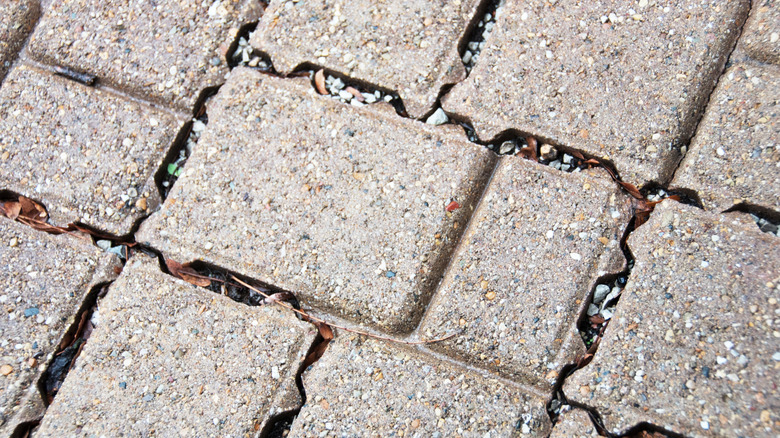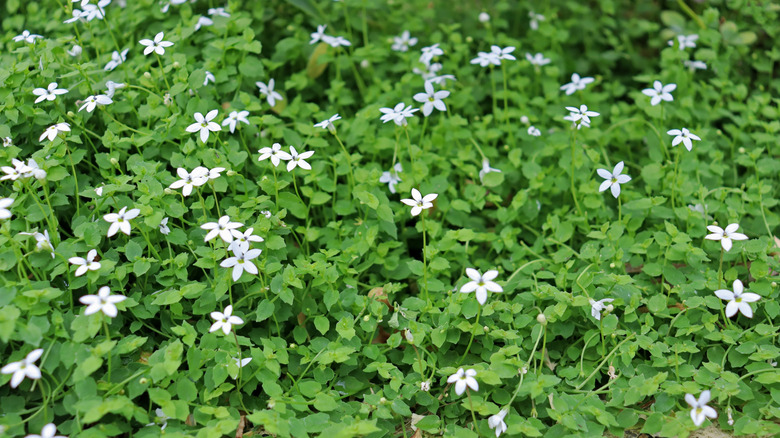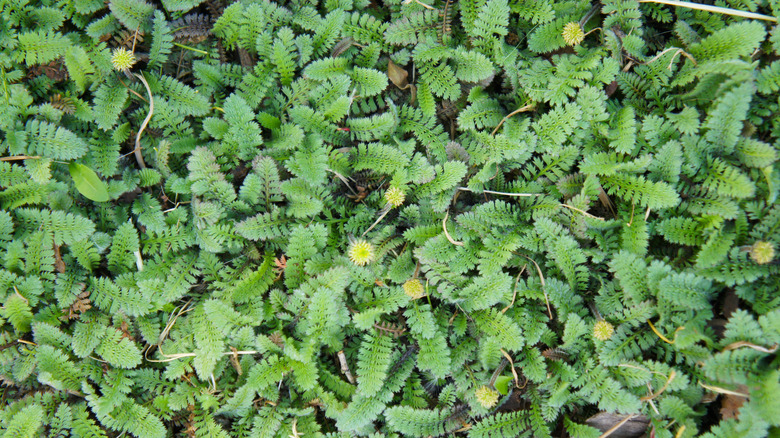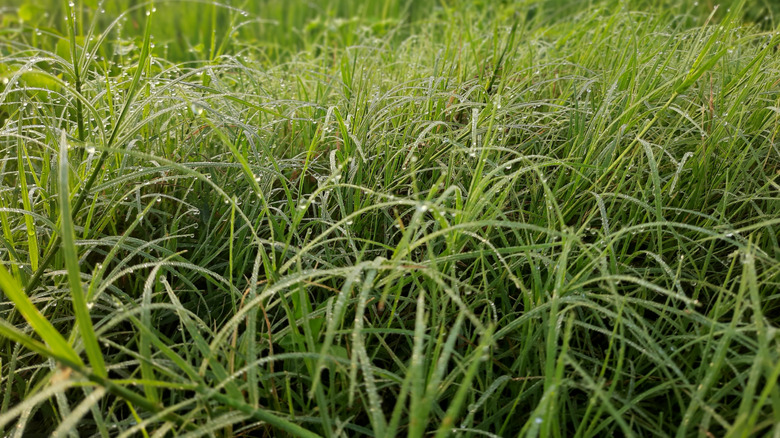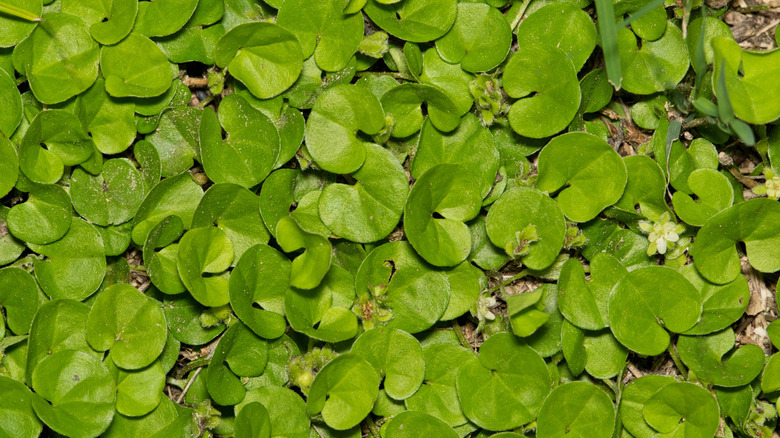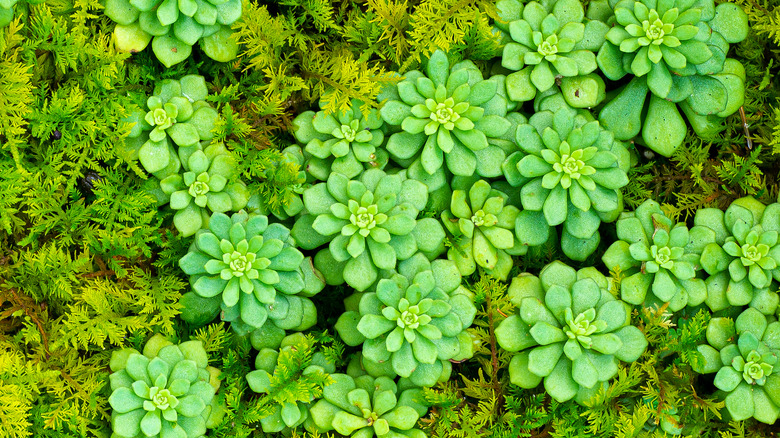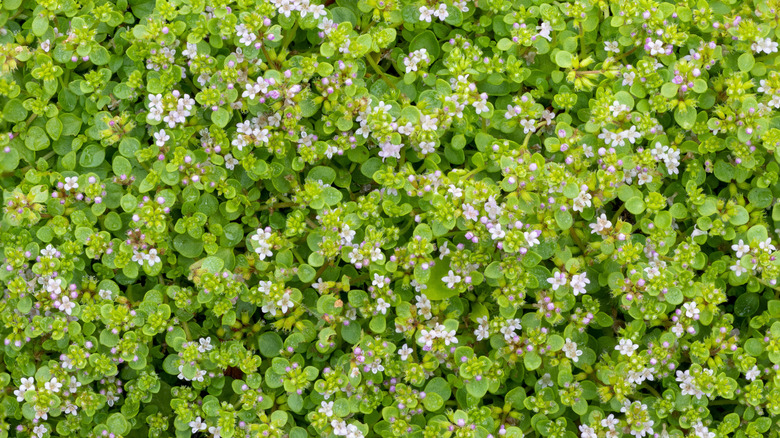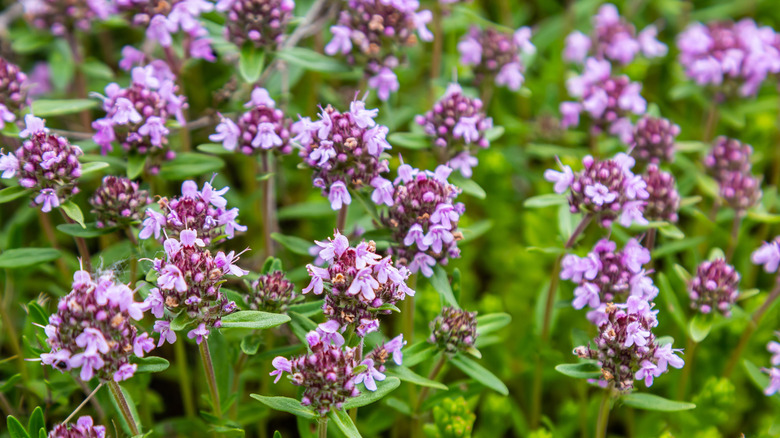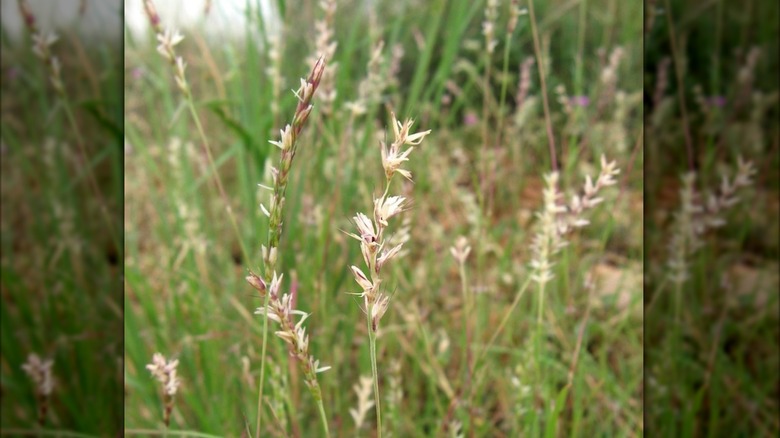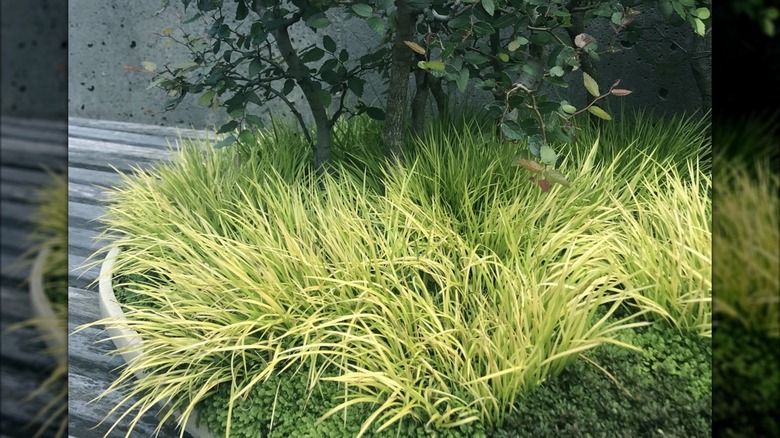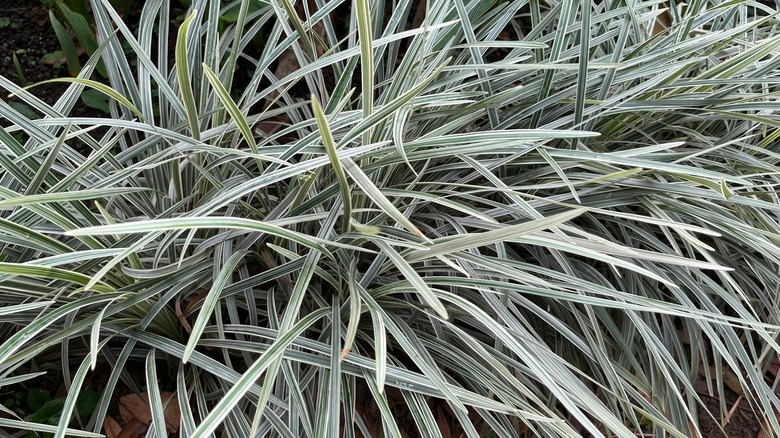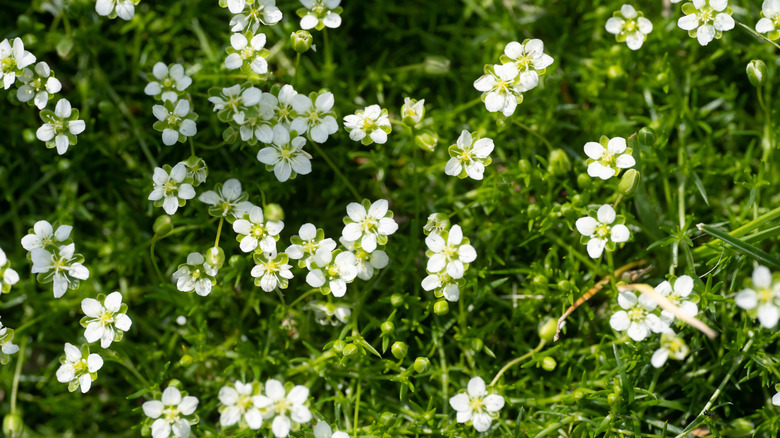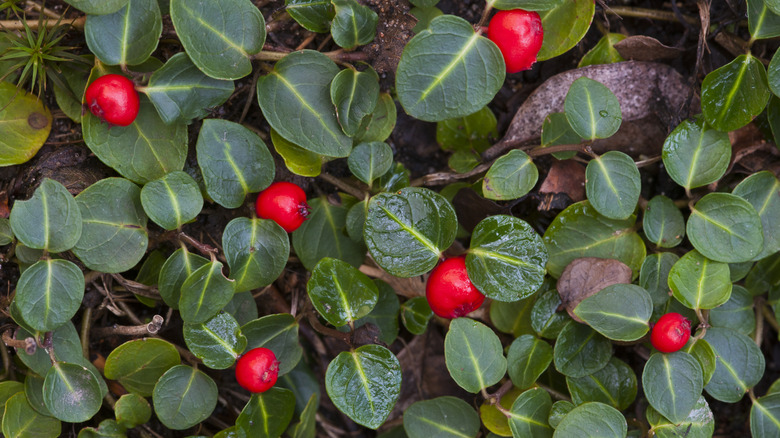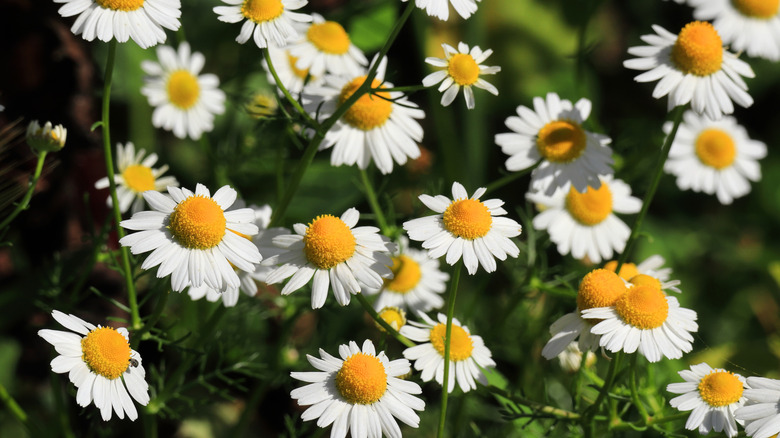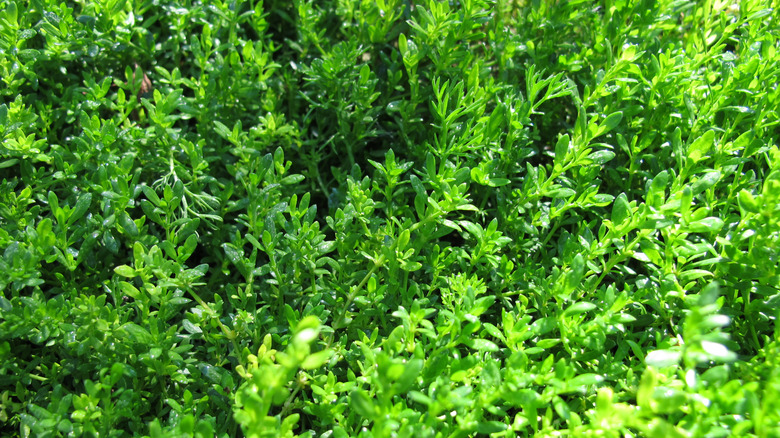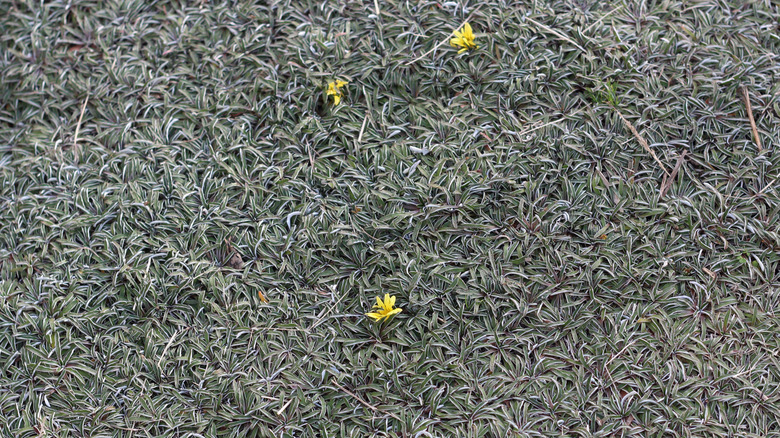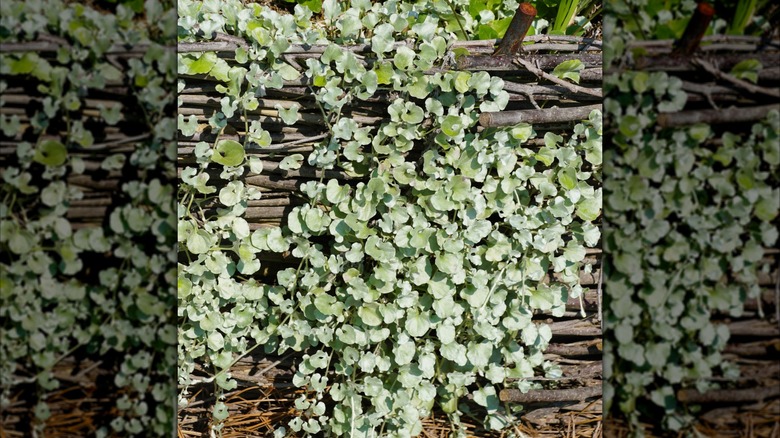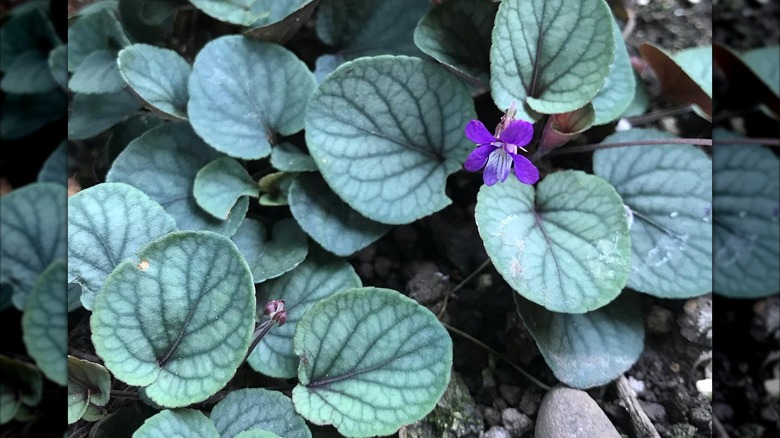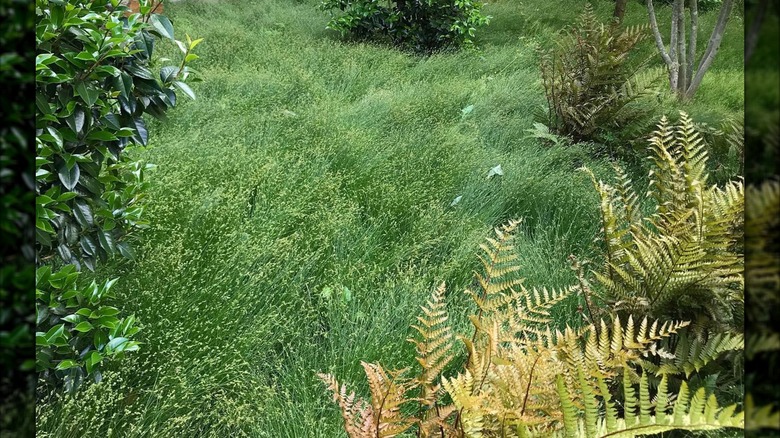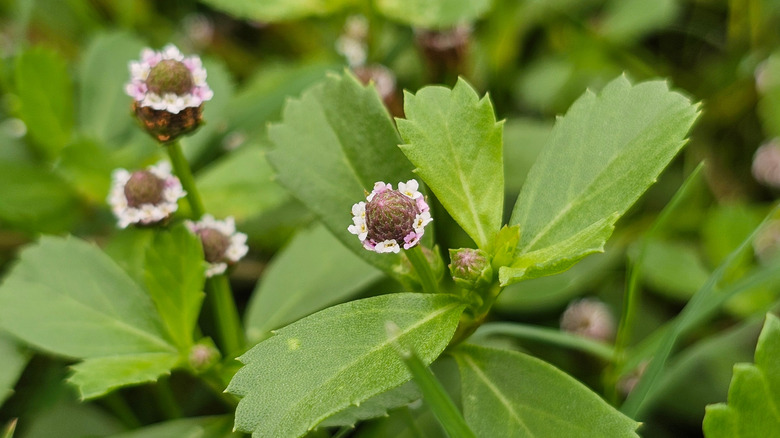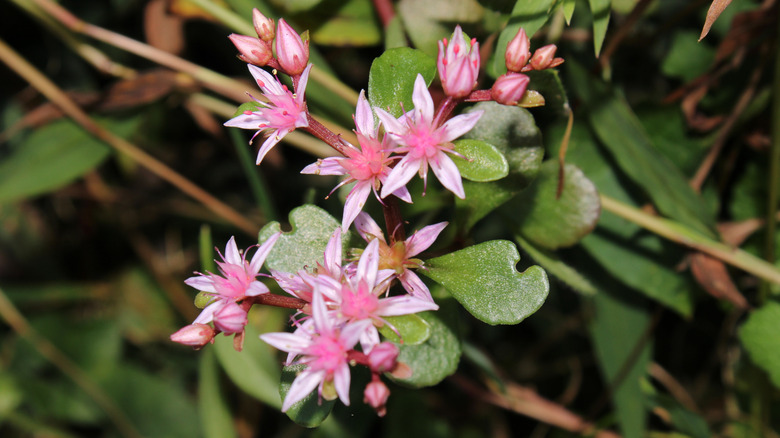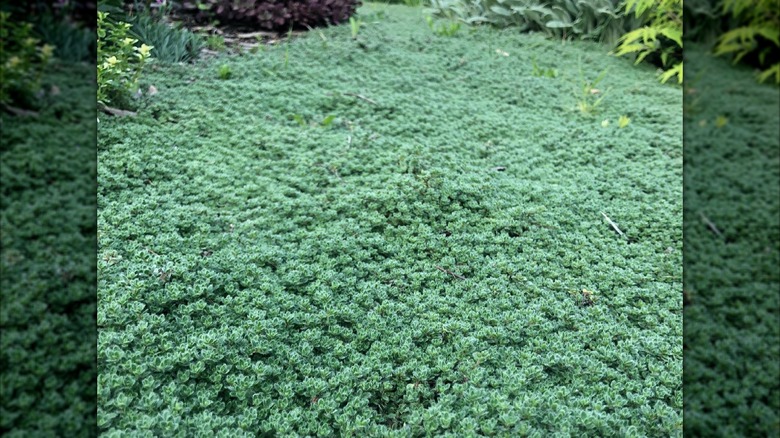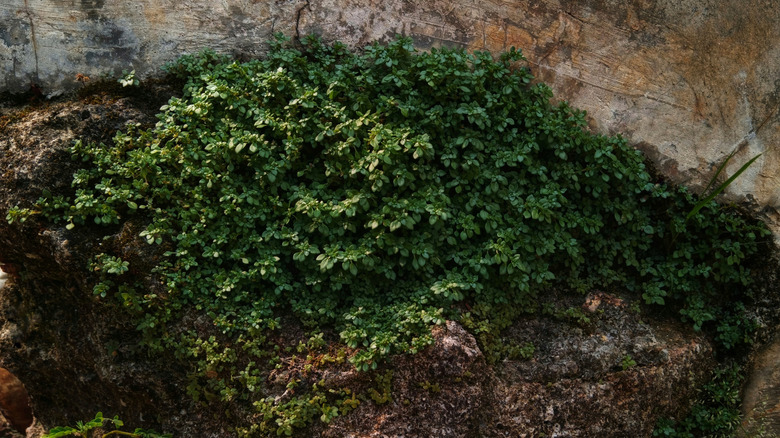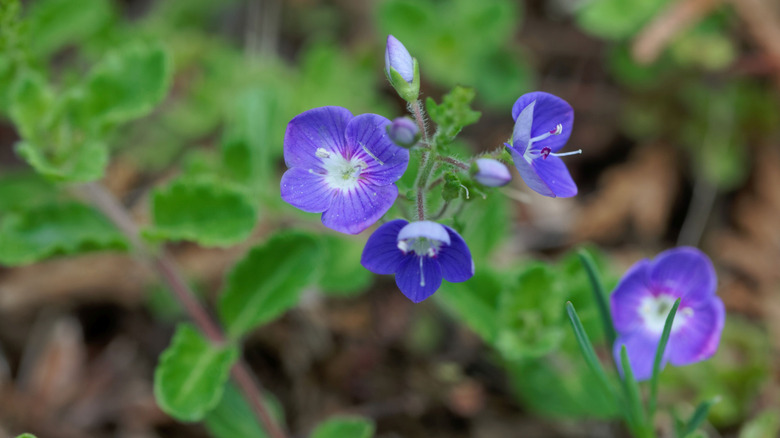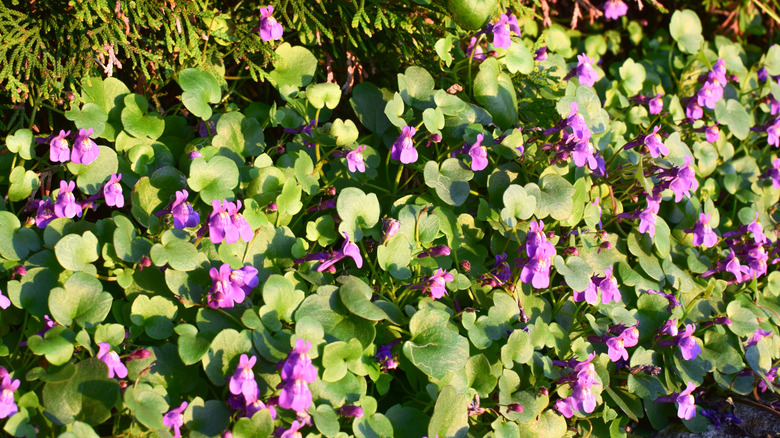Try These 24 Practical Plants Between Your Pavers To Add Even More Beauty
Forget concrete slabs — after a while, even the most beautifully laid down pavers can start looking monotonous. Worse, if you don't take charge, Mother Nature converts all those gaping spaces between stones into her experimental lab for testing out miscellaneous weeds' perseverance. Fortunately, things don't have to take such a morbid turn if you're ready to make some effort. With the right mix of low-growing plants, such as blue star creeper, creeping thyme, Irish moss, Corsican mint, and stonecrop, you can rejig your pavers, splashing them with a wash of color and fragrance, sans weeds.
Before selecting plants for your pavers' in-between spaces, consider a few things. In addition to accounting for growth conditions — sunlight and drainage, in particular — you must factor in foot traffic. To illustrate, dwarf mondo grass will be infinitely better for cases where the pavers are walked on regularly vis-à-vis sedums. Similarly, pay heed to mature sizes, especially if you plan to keep things low maintenance. Opting for some of the taller-growing species, like buffalograss or curly mesquite grass, is perfectly fine — as long as you don't mind mowing the plants to a height that doesn't interfere with your use of the pavers. With that said, below, we've lined up some of the best plants worth growing between your pavers.
Blue star creeper
Consider blue star creeper (Isotoma fluviatilis) for pavers that get little sunlight or are shadowed by tall shrubs. From spring through summer, it bursts out pale blue flowers. And its tiny, evergreen leaves do the rest of the heavy lifting for year-round color, regardless of heavy romping. Blue star creeper tops out at 3 inches and sends out runners 2 feet away if it isn't restricted by the stony edges. It's best to grow it in rich soils in zones 6 through 8. It tolerates lean and damp soils and must be separated every spring.
Brass buttons
Add a feathery touch to your stepping stones with brass buttons (Leptinella squalida) — named after their ray-less flowers. Their fern-like, grayish-green foliage establishes a thick mat that may extend as far as the gaps allow but grows no taller than 2 inches. Brass buttons are cold hardy in zones 4 to 10. In the colder reaches of this range, the plant dies down for the winter while remaining evergreen in zones 9 and 10. It's great at withstanding foot abuse and looks lovely when crisscrossed with scotch moss (Sagina subulata).
Buffalograss
Buffalograss (Bouteloua dactyloides) can be a worthy addition in low-traffic areas. With its roots penetrating 6 feet deep into the soil, buffalograss checks erosion while establishing a thick, 12-inch-wide sod of gray-to-blue green blades. However, as it can grow 8 inches tall, mowing the grass to 2 inches until it turns dormant in mid-fall might be necessary. Alternatively, you can plant its 4-inch-tall cultivar, 'Stampede.' Buffalograss adapts well to the dry, sunny sites of zones 4 to 8. It's indifferent to most soils, thriving just as well in clay, alkaline, or impoverished conditions.
Carolina ponysfoot
For pavers balancing on moist soils in zones 8 through 11, consider Carolina ponysfoot (Dichondra carolinensis). It's another low-growing, edible herb (tops out at 2 inches) with good tolerance for foot traffic and humidity. Although it produces white flowers from spring through early fall, they're often enshrouded by dime-sized leaves. Carolina ponysfoot has a prostrate growth habit, shooting out rhizomes around 12 inches across. It'll also fit the bill for native plant gardeners from south-central to south-east U.S. regions. Site it in full sun or partial shade. It can withstand alkaline and sandy soils.
Cliff stonecrop
Cliff stonecrop (Sedum glaucophyllum) is another contender for your pavers' in-between areas. This is because it likes to inhabit the crevices of rocky slopes in its native range spanning Maryland, North Carolina, Virginia, and West Virginia. From late spring to mid-summer, it'll invigorate the area with white flowers, followed by fruits. It establishes a mat of blue-green leaves that tops out at 4 inches (it can grow to 6 inches with flowers). Typically, cliff stonecrop is pest resistant but may contract root and crown rot in unfavorable conditions. So, ensure it receives full sun and good drainage.
Corsican mint
Break the monotony of your concrete pavers with an edible herb that withstands some foot trampling: Corsican mint (Mentha requienii). Unlike most of its minty brethren, this non-invasive European native is a low grower, maxing out at a ¼ foot, albeit extending four times as wide. It's best used in moderately shaded sites containing rich, moist soils. However, with assured protection during afternoons, it can survive in sunny sites. North of zone 6, Corsican mint is frost-killed but will return yearly since it self-seeds. Conversely, in southern ranges, you might have to pull volunteer seedlings to keep it controlled.
Creeping thyme
If your walkways play host to recreational activities round-the-clock, opt for creeping thyme (Thymus serpyllum), as it holds up well to heavy traffic. Since it sprawls 3 feet wide, it can be used in large spaces; however, it tops out at 4 inches. In summer, watch the butterflies and bees enjoying the purplish-pink flowers contrasting against the stone slabs. While it's cold hardy in zones 4 through 9, creeping thyme may not be reliably evergreen if the winters are severe in its upper range. It survives in most soils, including impoverished and gritty, with full sun.
Curly mesquite grass
Another grass-like alternative befitting paver gaps that's native to certain U.S. regions, including Texas, Arizona, and New Mexico, is curly mesquite grass (Hilaria belangeri). It's similar to buffalograss with curly, grayish-green blades, albeit with superior drought performance. However, it will turn strawy when it's hit by frost. Curly mesquite does fall on the taller side, as it can soar 12 inches high when left unmowed. So, be prepared for a few trimming sessions now and then. While it seeds, it primarily spreads using stolons, forming a dense carpet that's 13 feet wide.
Dwarf golden variegated sweet flag
Dwarf golden variegated sweet flag (Acorus gramineus 'Minimus Aureus') can be a suitable option in areas receiving copious rainfall or where drainage isn't the best. That's because it has a good tolerance for boggy environments. Plus, it doesn't grow very tall, staying under 6 inches at maturity. Plant in the crevices of full-to-partially sunny walkways in zones 5 to 7 and enjoy the citrusy scent as you walk over the yellow-mottled, green mat. Though an Asian native, 'Minimus Aureus' doesn't become invasive, instead establishing a dense mat slowly.
Dwarf mondo grass 'Nana'
Dwarf mondo grass 'Nana' (Ophiopogon japonicus 'Nana') is an evergreen ground cover plant that loves shade. However, it can be grown in full-sun-exposed areas if watered on the heavier side, and slight yellowing foliage is acceptable. Initially, it's a tufted mass of 6-inch long, lance-like green leaves, which extend 1 foot across over time via their stolons, provided the stone gaps allow. Mondo grass is fairly low maintenance since it requires no mowing. However, limit its usage to low-traffic areas, or its grass-like blades will come apart. It's hardy in zones 7 to 10.
Irish moss
Despite its name, Irish moss (Sagina subulata) isn't a moss but an herbaceous perennial that heralds spring with aromatic, daisy-esque white flowers. It has little tolerance for dark, gloomy places, choosing to room in sunny spots in zones 4 through 8. Its emerald carpet stands under 2 inches tall, making it a breeze to squeeze Irish moss between pavers. However, it may take several years to extend 1 foot wide. Moreover, it's fairly tolerant of traffic. Irish moss may self-sow, so keep track of any volunteer seedlings. Explore the 'Aurea' cultivar for its chartreuse foliage.
Partridgeberry
Endemic throughout central and eastern U.S., partridgeberry (Mitchella repens) is a red berry ground cover that'll bring beautiful birds to your yard. However, as the 3-inch-tall perennial creeps over 1 foot across (albeit at a slow pace), it can also be used to fill in the spots between pavers. That way, you can enjoy its perfumed, pink-tinged white flowers in the summer. Partridgeberry remains evergreen in zones 3 to 8, but requires acidic, humusy soils. It thrives in all lighting conditions, from full sun to heavy shade. Unfortunately, it performs poorly in drought-stressed locations.
Roman chamomile
Light foot traffic, droughts, and poor soils pose no challenge to Roman chamomile (Chamaemelum nobile), making it a go-to evergreen perennial in zones 4 through 9. The non-invasive European beauty brightens the area with its daisy-esque flowers when they bloom atop downy-haired foliage from summer through fall. When placed between flagstones, Roman chamomile infuses the area with a pleasant aroma while it's crushed underneath walking feet. It grows best in full sun but will tolerate some shade. Avoid this plant if you have furry friends who might chomp down on its toxic leaves.
Rupturewort
Hardy in zones 5 through 10, rupturewort (Herniaria glabra) is a low-maintenance, evergreen ground cover plant that can make itself at home between paver stones. Its bright green leaves spread around 2 feet wide, effectively choking out weeds without breaking a sweat when stepped on. Moreover, it has a deep taproot, which adds to its drought tolerance, making it a suitable planting option in dry sites. Commercially sold as Green Carpet, rupturewort caps out at 3 inches. Despite its self-seeding tendencies, it doesn't become invasive. Grow it in partially shaded or fully sunny sites.
Silver carpet
If you want a low-growing plant that you can tread on as it lies flat between the stones, look no further than silver carpet (Dymondia margaretae). This narrow-leaved ground cover boasts a silverish, evergreen foliage that never grows beyond 3 inches in height, even when adorned by its dainty yellow flowers in the summer. To encourage dense matting, water the plant generously while it's still young. Applying organic fertilizer annually in the spring helps, too. While its leaves don't attract deer, gophers are a different story. It doesn't survive below 28 degrees Fahrenheit.
'Silver Falls' Dichondra
Soften your pavers' appearance with the cascading, silverish-green, fan-shaped blades of 'Silver Falls' Dichondra (Dichondra argentea 'Silver Falls') in zones 10 to 12. This Dichondra cultivar can creep 4 feet across if the space allows, effusively suppressing all weeds, even when you get lazy with watering. It has a high tolerance for heat and can easily be popped into the sunniest sites. However, it will tolerate filtered shade. 'Silver Falls' matures to a height of 4 inches and is generally pest and disease resistant. It prefers sandy loam soils.
Silver Gem prostrate blue violet
At 5 inches, 'Silver Gem' prostrate blue violet (Viola walteri 'Silver Gem') is a relatively tall option to plug paver gaps, but it has its perks. For starters, it crops gorgeous, blueish, heart-shaped leaves that cradle dainty lavender flowers from spring through the start of summer. It also promises year-round color with its evergreen leaves in zones 6 to 8, provided winters remain mild. Better yet, it tolerates a fair share of trampling. Pop it in dappled or partially shaded areas, preferably containing alkaline soils. Keep the soils dry to discourage the plant's colonizing tendencies.
Texas sedge
Consider growing Texas sedge (Carex texensis) in dry, shaded locations subject to light foot traffic. It has very fine-textured, smooth green leaves that team well with pavers. While this ornamental sedge is hardy in zones 5 through 9, it turns strawy and discolored by late winter, so make your call accordingly. Also, consider underwatering the plant, as it tends to grow higher (breaching 1-foot height) the more moisture it gets. Since it's drought and dry soil tolerant, it's unlikely to take much of a hit post-establishment. Texas sedge grows well in shallow-rocky, clay, humusy, and sandy soils.
Turkey tangle frogfruit
Native in the south U.S., turkey tangle frogfruit (Phyla nodiflora) is another low-maintenance ground cover that works well between pavers. It remains evergreen in frost-protected areas but will not survive the harsher winters north of zone 6. Starting in spring, it adds a pop of color thanks to the pollinators, including butterflies, hummingbirds, and bees dotting its purplish-white flowers, right through the fall. It's cavalier about soils, tolerating both flooding and drought stress. Depending on the space available, this fast-growing plant can creep 2 feet across while towering 6 inches high. It grows in full-to-partial sun.
Woodland stonecrop
Renowned as an evergreen ground cover for stunning color all year round, woodland stonecrop (Sedum ternatum) promises to fit right between your stepping stones and make them look attractive. In zones 3 to 9, it produces a mass of purple-toned white blooms, followed by summer fruits. While it's mostly evergreen, in severe winters, and especially under traffic abuse, its stems tend to split apart and drop their leaves. However, the plant will return early next spring, rooting at the split portions.
Woolly thyme
True to its name, woolly thyme (Thymus pseudolanuginosus) sprouts the hairiest stems of all creeping thyme varieties, forming a 1-foot-thick mat. Since it grows no taller than a ¼ foot and exhibits significant tolerance for foot traffic, you easily tuck it between paver stones without risking any slip hazards. Ensure its soil drains well, or it'll rot. Shallow-rocky and dry soils teamed with full sun exposure offer the best performance. While it's winter hardy through zone 5, it must be shielded from cold winds to prevent damaging its evergreen foliage. Bees and butterflies visit woolly thyme's summer-blooming pink flowers.
Corsican sandwort
Looking for a plant that survives in deep or filtered shade, compacted soils, and a damp environment? Meet Corsican sandwort (Arenaria balearica). Quite similar to Irish moss, Corsican sandwort carpets the ground in moss-like, deep green blades that may spread 18 inches wide. Around spring's end, it'll lace your pavers with delicate white blooms. It's a slow grower but has the capacity for light foot trampling. In zones 4 through 9, it'll top out at 2 inches. Sandy soils are favored, though it doesn't like them drying out for extended durations.
Thyme-leaf speedwell
Although a slow grower, thyme-leaf speedwell (Veronica oltensis) looks especially nice when filling the gaps between pavers. Its lacy green leaves could pass off for any creeping thyme variety — minus the fragrance. But what truly makes it a standout ground cover is the profuse display of blue flowers toward the spring's tail end. Thyme-leaf speedwell reliably thrives as a perennial in zones 4 through 9 and doesn't grow higher than 1 inch. If allowed, its evergreen mat can extend 2 feet wide. Expose it to direct sunlight for a minimum of six hours. It's drought tolerant.
Kenilworth ivy
Cold hardy in zones 6 through 10, Kenilworth ivy (Cymbalaria muralis) is another low-growing perennial worthy of your consideration. It grows a mass of rounded leaves that often get decked by pink-toned, yellow-eyed, lilac flowers (very reminiscent of snapdragons) during the summer. It sends runners that root wherever they contact soil, which makes them great for filling up the paver's fissures. However, it doesn't fare well with foot traffic and may turn semi-evergreen in severe winters. Kenilworth ivy is ideal for partially or deeply shaded yards with well-draining soils. You might have to remove volunteers as it self-seeds.
